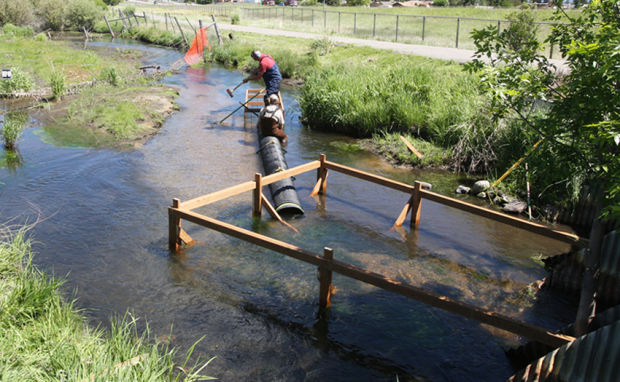
Recognize this handsome face? Martinez should especially. This is Skip Lisle who installed our flow device at Alhambra Creek 6 years and 2 weeks ago. He and beavers are the subject of an excellent article in the winter 2013 issue of Woodland by Madeline Bodin.
Skip Lisle has been living with beavers all his life. The relationship hasn’t always been a peaceful one. As a child, his family moved to a forested valley in southern Vermont. Lisle grew up hunting and fishing, so when beavers dammed the road culvert next to the house, threatening to flood the road, his parents assigned him the chore of shooting the beavers to eliminate the problem. But soon, new beavers came and dammed the same culvert.
Lisle, young as he was, knew there had to be a better way to deal with the beavers. He began developing a solution as a teenager. After years of working in construction and earning a master’s degree in wildlife management, he perfected it.
Today Lisle lives with his family in the house where he grew up. The house is surrounded by a horseshoe-shaped beaver pond and expansive wetlands. The dirt road next to the house remains dry. Wood ducks and mergansers nest on the pond. Frogs trill and red-winged blackbirds sing there each spring. Moose wade, looking for lunch. On summer evenings Lisle and his wife relax on a deck at the water’s edge, keeping an eye out for the v-shaped wakes on the pond that show that their busy neighbors are at work.
Mind you, yesterday when Mary O’brien sent me the article I was stunned to find it had a huge photo of a NUTRIA in the opening paragraphs. I of course laughed hardily and wrote the editor who last night wrote me back sheepishly that they had paid for a stock photo that was mislabled. What a surprise! But this morning when I look at the site the nutria is gone and a beaver is there instead. Like magic! (Heidi magic?)
In the West, beavers provide an additional benefit. “In the arid regions, water is life,” says Jeremy Christensen, a wildlife associate with the Grand Canyon Trust, a group that works to conserve the Colorado Plateau. “When beavers build dams, they create a capture-and-storage system for rainfall and snow.”
You bet they do! Thanks Jeremy! When I despair that all the big beaver players are going to turn 70 in a decade or so and they’ll be no one left to carry on this work, I remember Jeremy Christensen, and Amy Chadwick, and Adrian Nelson. Beavers: the next generation.
“Since humans want to harvest trees and beavers want to harvest trees, it can be hard for them to coexist,” says Michael Callahan, owner of Beaver Solutions, a Massachusetts based beaver consultant and mitigation expert.
When they have a choice, beavers eat willow and aspen, trees with low value. But tree chewing is usually a minor issue, the experts say. It is the beavers’ dam building that typically causes the most costly damage, plugging culverts and flooding roads. Sometimes beavers will create a pond over a well or other drinking water supply, which is a health hazard.
To reap the benefits that beavers provide, says Callahan, “the key is to keep them welcome, and that means intervening when they cause problems for people.”
Skip and Mike in the same article! This reads like a Who’s who of beavers. The article clearly outlines protecting culverts, controlling pondheight, and discusses relocation being an option in some states. It even talks to Jimmy Taylor.
Studies by the U.S. Forest Service and local public utilities confirm that flow-control devices have a high success rate. But sometimes a landowner can’t use such a device at a beaver problem site, says Jimmy Taylor, the project leader for the U.S. Department of Agriculture’s National Wildlife Research Center.
Hmmm, Skip, Mike, Jeremy, Jimmy, what about Sherri? Don’t worry, here she is:
Tippie began live-trapping beavers in 1985, when she saw on the news that beavers on a Colorado golf course were going to be killed. A professional dancer and hairdresser at the time, she borrowed traps from the state division of wildlife and found a home in Rocky Mountain National Park for the beavers she caught.
Wow what a great article! You really should go read the whole thing! The only thing missing is urban beavers and a certain BEAVER FESTIVAL which I won’t even mention. Of course if the author had talked to me, I could have told her not to run that silly nutria photo in the first place.
Just sayin’…
While others may look at beavers and see a nuisance, Lisle, sitting in his living room overlooking the beaver pond, sees redemption. “ When the Earth is losing natural landscapes every day,” he says, “it is incredibly powerful and encouraging that we are gaining these marshes and meadows.”



















































